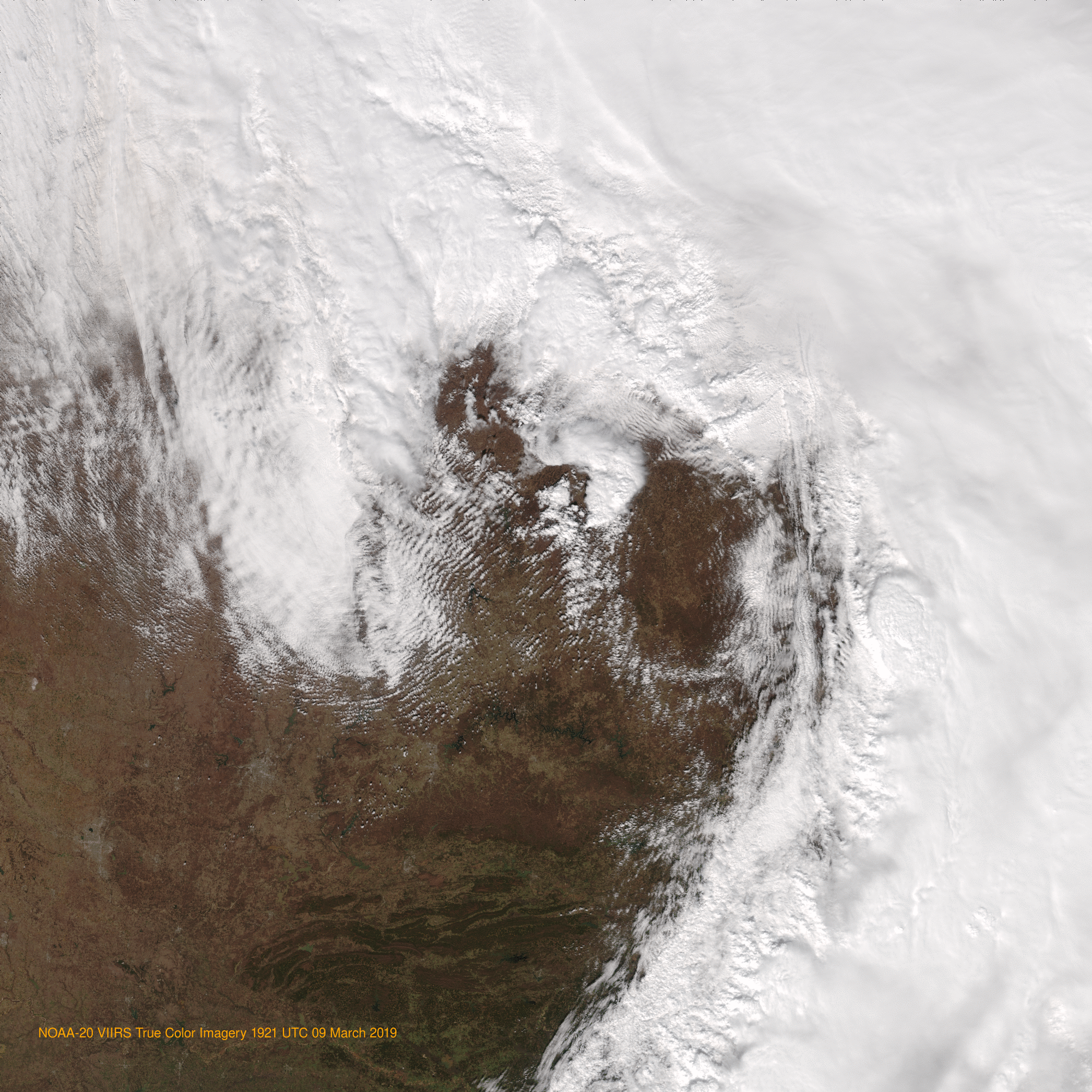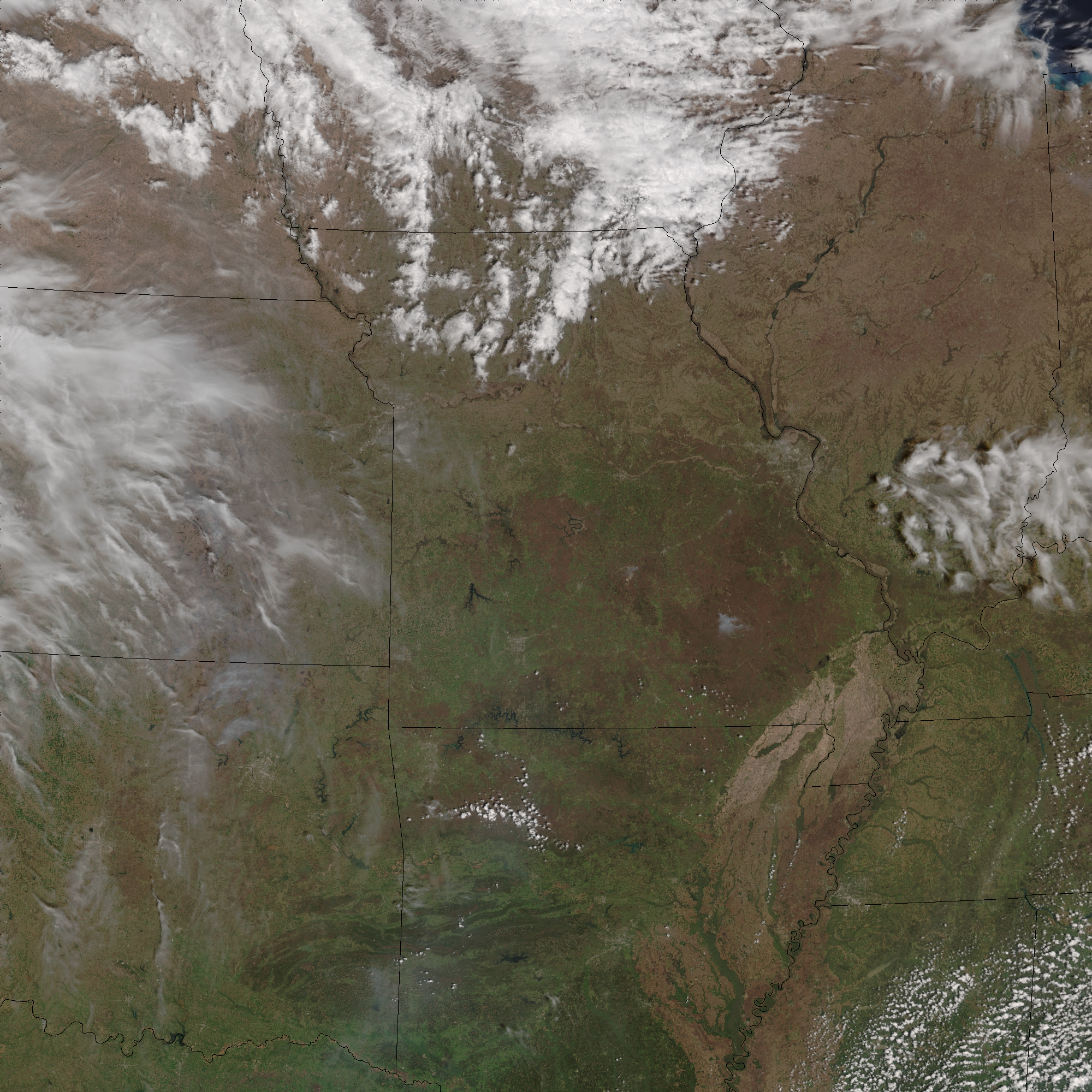Use Polar2Grid to create VIIRS True Color imagery over one State (Missouri)
Polar2Grid allows users to create true-color imagery from VIIRS (Visible Infrared Imaging Radiometer Suite) data from Suomi-NPP or NOAA-20. This tutorial will take you through the needed steps. Step one is to decide when you want the data; the ways to determine when a Polar Orbiter overflies a particular point are outlined in this blog post, that points to this website. For this blog post I’ve chosen Missouri. The image above shows a True-Color image over Missouri at about 19:42 UTC on 9 April 2019.
To create true-color imagery, Polar2Grid requires VIIRS M-Bands 3, 4 and 5 (Blue (0.48 µm), Green (0.55 µm) and Red (0.67 µm), respectively, all with 750-m resolution); click here for a list of all VIIRS bands). If the VIIRS I-Band 1 (at 0.64 µm) is present in the directory, then that image is used to sharpen the resultant image. Polar2Grid CREFL software also performs a simple atmospheric Rayleigh scattering removal; smoke and haze will still be apparent in the imagery, however.
To create the imagery above, first order the data from NOAA Class. (Steps to follow are shown here). Download the data into a unique directory. We are going to remap these data onto a map centered on Missouri, and for that to happen, Polar2Grid needs mapping parameters. These can be generated automatically with the p2_grid_helper.sh script that comes with Polar2Grid software. From the bin directory, I entered this command to put the grid parameters in a file .
/p2g_grid_helper.sh missouri -93.0 38.0 500 -500 2000 2000 > my_grids.txt
The line of data entered into that file is this:
missouri, proj4, +proj=lcc +datum=WGS84 +ellps=WGS84 +lat_0=38.000 +lat_1=38.000 +lon_0=-93.000 +units=m +no_defs, 2000, 2000, 500.000, -500.000, -99.055deg, 42.352deg
Now I’m ready to generate a true-color image (corrected ceflectance — crefl — imagery) with Polar2Grid, using this command:
./polar2grid.sh crefl gtiff –grid-configs /home/scottl/Polar2Grid/polar2grid_v_2_2_1/bin/my_grids.txt -g missouri -f /data-hdd/storage/Polar2GridData/09April/
The flags “–grid-configs <path to directory where file created by p2g_grid_help sits” and “-g map <name of map inside that file>” instruct to the Polar2Grid software to pull the mapping data for the defined grid out of the file. Otherwise, the data are in satellite projection. This polar2grid.sh invokation created a file named ‘j01_viirs_true_color_20190409_194226_missouri.tif’; I want to put a map on it so it is easier to georeference, and that is done using this shell in the Polar2Grid bin directory:
./add_coastlines.sh –add-borders –borders-resolution=f –borders-level=2 –borders-outline=’black’ j01_viirs_true_color_20190409_194226_missouri.tif
This adds a map to the image, then converts it to the png file (j01_viirs_true_color_20190409_194226_missouri.png) that is shown above.
After doing the same steps for a series of clear days in the midwest (09 March 2019, 15 March 2019, 21 March 2019, 26 March 2019, 31 March 2019), and annotating and concatenating the images in an animation, the greening up of Spring is apparent. See below.

NOAA-20 VIIRS True Color Imagery on select mostly clear days over the mid-Mississippi Valley, dates and times as indicated in the image (Click to enlarge)
Special shout-out to Dave Hoese, SSEC/CIMSS, for crafting software that is so easy to use to produce excellent satellite imagery.


